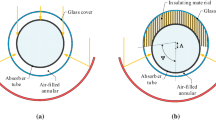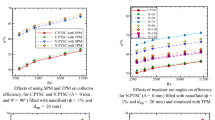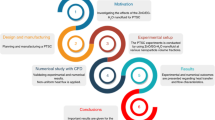Abstract
The main objective of the present work is to investigate the morphology effects of Syltherm 800 oil-based \( \upgamma {\text{-AlOOH}} \) nanofluid on performance evaluation criterion (PEC) and energy efficiency of a novel parabolic trough solar collector (PTSC) numerically using finite volume method. The other goal is to compare the obtained results of nanofluid simulation in PTSC using single-phase mixture model (SPM) with two-phase mixture model (TPM). In addition, influences of using acentric absorber tube are determined. Consequently, in this step the optimum configuration is introduced and then different nanofluids characteristics such as volume fractions, nanoparticles diameters and shapes on the optimum configuration are investigated. Based on the obtained results, for all studied cases, obtained PEC and energy efficiencies employing the TPM in nanofluid simulation are more than that SPM simulation. Using the novel PTSC leads to the higher average Nusselt number, energy efficiency, PEC and outlet temperature at all Reynolds numbers. For all cases, the PEC and energy efficiency increase by reduction of nanoparticle volume fraction and diameter. As the Reynolds number increases, the energy efficiency of PTSC increases for all studied cases till Reynolds number equal to 5000 and then always reduces. Therefore, the optimum Reynolds number is 5000. The optimum morphology is related to the nanoparticles shape of blade which is followed by the brick, cylinders and platelet, respectively.



















Similar content being viewed by others
References
Salgado Conrado L, Rodriguez-Pulido A, Calderon G (2017) Thermal performance of parabolic trough solar collectors. Renew Sustain Energy Rev 67:1345–1359
Fuqiang W, Ziming C, Jianyu T, Yuan Y, Yong S, Linhua L (2017) Progress in concentrated solar power technology with parabolic trough collector system: a comprehensive review. Renew Sustain Energy Rev 79:1314–1328
Bellos E, Tzivanidis C, Daniil I (2017) Energetic and exergetic investigation of a parabolic trough collector with internal fins operating with carbon dioxide. Int J Energy Environ Eng 8:109–122
Bellos E, Tzivanidis C (2018) Assessment of the thermal enhancement methods in parabolic trough collectors. Int J Energy Environ Eng 9:59–70
Suman S, Khan MK, Pathak M (2015) Performance enhancement of solar collectors a review. Renew Sustain Energy Rev 49:192–210
Lei D, Ren Y, Wang Z (2020) Numerical study of conduction and radiation heat losses from vacuum annulus in parabolic trough receivers. Front Energy. https://doi.org/10.1007/s11708-020-0670-7
Aldulaimi RKM (2019) An innovative receiver design for a parabolic trough solar collector using overlapped and reverse flow: an experimental study. Arab J Sci Eng 44:7529–7539
Soudani ME, Aiadi KE, Bechki D, Chihi S (2017) Experimental and theoretical study of parabolic trough collector (PTC) with a flat glass cover in the region of algerian sahara (Ouargla). J Mech Sci Technol 31:4003–4009
Daffie JA, Beckman WA (2009) Solar engineering of thermal progress, 4th edn. Wiley, New York
Wang Q, Li J, Yang H, Su K, Hu M, Pei G (2017) Performance analysis on a high temperature solar evacuated receiver with an inner radiation shield. Energy 139:447–458
Khan MS, Yan M, Ali HM, Amber KP, Bashir MA, Akbar B, Javed S (2020) Comparative performance assessment of different absorber tube geometries for parabolic trough solar collector using nanofluid. J Therm Anal Calorim. https://doi.org/10.1007/s10973-020-09590-2
Mohamed MH, El-Sayed AZ, Megalla KF, Elattar HF (2019) Modeling and performance study of a parabolic trough solar power plant using molten salt storage tank in Egypt: effects of plant site location. Energy Syst 10:1043–1070
Al-Aboosi FY (2020) Models and hierarchical methodologies for evaluating solar energy availability under different sky conditions toward enhancing concentrating solar collectors use: Texas as a case study. Int J Energy Environ Eng 11:177–205
Timofeeva EV, Routbort JL, Singh D (2009) Particle shape effects on thermophysical properties of alumina nanofluids. J Appl Phys 106:014304
Abbasian Arani AA, Sadripour S, Kermani S (2017) Nanoparticle shape effects on thermal-hydraulic performance of boehmite alumina nanofluids in a sinusoidal–wavy mini-channel with phase shift and variable wavelength. Int J Mech Sci 128–129:550–563
Vanaki SM, Mohammed HA, Abdollahi A, Wahid MA (2014) Effect of nanoparticle shapes on the heat transfer enhancement in a wavy channel with different phase shifts. J Mol Liq 196:32–42
Mahian O, Kianifar A, Heris SZ, Wongwises S (2014) First and second laws analysis of a minichannel-based solar collector using boehmite alumina nanofluids: effects of nanoparticle shape and tube materials. Int J Heat Mass Transf 78:1166–1176
Ooi EH, Popov V (2013) Numerical study of influence of nanoparticle shape on the natural convection in Cu–water nanofluid. Int J Therm Sci 65:178–188
Elias MM, Miqdad M, Mahbubul IM, Saidur R, Kamalisarvestani M, Sohel MR, Hepbasli A, Rahim NA, Amalina MA (2013) Effect of nanoparticle shape on the heat transfer and thermodynamic performance of a shell and tube heat exchanger. Int Commun Heat Mass Transf 44:93–99
Elias MM, Shahrul IM, Mahbubul IM, Saidur R, Rahim NA (2014) Effect of different nanoparticle shapes on shell and tube heat exchanger using different baffle angles and operated with nanofluid. Int J Heat Mass Transf 70:289–297
Khan I (2017) Shape effects of MoS2 nanoparticles on MHD slip flow of molybdenum disulphide nanofluid in a porous medium. J Mol Liq 233:442–451
Hajabdollahi H, Hajabdollahi Z (2017) Numerical study on impact behavior of nanoparticle shapes on the performance improvement of shell and tube heat exchanger. Chem Eng Res Des 125:449–460
Avella M, Cosco S, Di Lorenzo ML, Di Pace E, Errico ME (2005) Influence of CaCO3 nanoparticles shape on thermal and crystallization behavior of isotactic polypropylene based nanocomposites. J Therm Anal Calorim 80:131–136
Fang X, Ding Q, Fan LW, Yu ZT (2013) Enhanced thermal conductivity of ethylene glycol-based suspensions in the presence of silver nanoparticles of various sizes and shapes. In: Proceedings of the ASME 2013 heat transfer summer conference, HT2013, July 2013, Minneapolis, MN, USA, pp 14–19
Ferrouillat S, Bontemps A, Poncelet O, Soriano O, Gruss JA (2013) Influence of nanoparticle shape factor on convective heat transfer and energetic performance of water-based SiO2 and ZnO nanofluids. Appl Therm Eng 51:839–851
Ellahi R, Hassan M, Zeeshan A, Khan AA (2016) The shape effects of nanoparticles suspended in HFE-7100 over wedge with entropy generation and mixed convection. Appl Nanosci 6(5):641–651
Karimi-Nazarabad M, Goharshadi EK, Youssefi A (2016) Particle shape effects on some of the transport properties of tungsten oxide nanofluids. J Mol Liq 223:828–835
Sheikholeslami M, Bhatti MM (2017) Forced convection of nanofluid in presence of constant magnetic field considering shape effects of nanoparticles. Int J Heat Mass Transf 111:1039–1049
Monfared M, Shahsavar A, Bahrebar MR (2019) Second law analysis of turbulent convection flow of boehmite alumina nanofluid inside a double-pipe heat exchanger considering various shapes for nanoparticle. J Therm Anal Calorim 135(2):1521–1532
Al-Rashed AAAA, Ranjbarzadeh R, Aghakhani S, Soltanimehr M, Afrand M, Nguyen TK (2019) Entropy generation of boehmite alumina nanofluid flow through a minichannel heat exchanger considering nanoparticle shape effect. Phys A. https://doi.org/10.1016/j.physa.2019.01.106
Alsarraf J, Moradikazerouni A, Shahsavar A, Afrand M, Salehipour H, Tran MD (2019) Hydrothermal analysis of turbulent boehmite alumina nanofluid flow with different nanoparticle shapes in a minichannel heat exchanger using two-phase mixture model. Physica A 520:275–288
Sadripour S, Chamkha AJ (2019) The effect of nanoparticle morphology on heat transfer and entropy generation of supported nanofluids in a heat sink solar collector. Therm Sci Eng Prog 9:266–280
Shahsavar A, Rahimi Z, Salehipour H (2019) Nanoparticle shape effects on thermal-hydraulic performance of boehmite alumina nanofluid in a horizontal double-pipe minichannel heat exchanger. Heat Mass Transf 55(6):1741–1751
Kaloudis E, Papanicolaou E, Belessiotis V (2016) Numerical simulations of a parabolic trough solar collector with nanofluid using a two-phase model. Renew Energy 97:218–229
Benabderrahmane A, Benazza A, Laouedj S, Solano JP (2017) Numerical analysis of compound heat transfer enhancement by single and two-phase models in parabolic through solar receiver. Mechanika 23(1):55–61
Borgnakke C, Sonntag RE (2018) Fundamentals of thermodynamics, 7th edn. Wiley, New York
Sadripour S (2019) 3D numerical analysis of atmospheric-aerosol/carbon-black nanofluid flow within a solar air heater located in Shiraz, Iran. Int J Num Methods Heat Fluid Flow 29(4):1378–1402
Dudley V, Kolb G, Sloan M, Kearney D (1994) SEGS LS2 Solar Collector Test Results, Report of Sandia National Laboratories, Report No. 94-1884
Dow Chemical Company, Syltherm 800 Heat Transfer Fluid, Product Technical Data, Dow, 1997
Corcione M (2011) Empirical correlating equations for predicting the effective thermal conductivity and dynamic viscosity of nanofluids. Energy Convers Manag 52:789–793
Keblinski P, Phillpot SR, Choi SUS, Eastman JA (2002) Mechanisms of heat flow in suspensions of nano-sized particles (nanofluids). Int J Heat Mass Transf 45:855–863
Incropera FP, Dewitt DP, Bergman TL, Lavine AS (2006) Fundamentals of heat and mass transfer, 6th edn. Wiley, New York
Chandra YP, Singh A, Mohapatra SK, Kesari JP, Rana L (2017) Numerical optimization and convective thermal loss analysis of improved solar parabolic trough collector receiver system with one sided thermal insulation. Sol Energy 148:36–48
Padilla RV, Demirkaya G, Goswami DY, Stefanakos E, Rahman MM (2011) Heat transfer analysis of parabolic trough solar receiver. Appl Energy 88:5097–5110
Schlunder EU (1983) Heat exchanger design handbook, vol 4. Hemisphere Publication Corporation, Washington, DC
Gnielinsli V (2009) Heat transfer coefficients for turbulent flow in concentric annular ducts. Heat Transf Eng 30(6):431–436
Siegel R, Howell JR (1971) Thermal radiation heat transfer. McGraw-Hill, New York
Dushman S (1962) Scientific foundations of vacuum technique. Wiley, New York
Kakat S, Shah RK, Aung W (1987) Handbook of single-phase convective heat transfer. Wiley, New York
ANSYS Inc (2009) Ansys CFX-solver theory guide. ANSYS Inc, Canonsburg
Behzadmehr A, Saffar-Avval M, Galanis N (2007) Prediction of turbulent forced convection of a nanofluid in a tube with uniform heat flux using a two phase approach. Int J Heat Fluid Flow 28:211–219
Hejazian M, Moraveji MK, Beheshti A (2014) Comparative study of Euler and mixture models for turbulent flow of Al2O3 nanofluid inside a horizontal tub. Int Commun Heat Mass Transf 52:152–158
Goktepe S, Atalk K, Ertrk H (2014) Comparison of single and two-phase models for nanofluid convection at the entrance of a uniformly heated tube. Int J Therm Sci 80:83–92
Patankar SV (1980) Numerical heat transfer and fluid flow. Taylor & Francis Group, Milton Park
Schiller L, Naumann A (1935) A drag coefficient correlation. Z Ver Dtsch Ing 77:318–320
He YL, Xiao J, Cheng ZD, Tao YB (2011) A MCRT and FVM coupled simulation method for energy conversion process in parabolic trough solar collector. Renew Energy 36:976–985
Sadaghiyani OK, Pesteei SM, Mirzaee I (2013) Numerical study on heat transfer enhancement and friction factor of LS-2 parabolic solar collector. J Therm Sci Eng Appl 6:012001–012010
Cheng Z, He Y, Xiao J, Tao Y, Xu R (2010) Three-dimensional numerical study of heat transfer characteristics in the receiver tube of parabolic trough solar collector. Int Commun Heat Mass Transf 37:782–787
Cheng Z, He Y, Cui F, Xu R, Tao Y (2012) Numerical simulation of a parabolic trough solar collector with non-uniform solar flux conditions by coupling FVM and MCRT method. Sol Energy 86:1770–1784
Sokhansefat T, Kasaeian A, Kowsary F (2014) Heat transfer enhancement in parabolic trough collector tube using Al2O3/synthetic oil nanofluid. Renew Sustain Energy Rev 33:636–644
Khakrah HR, Shamloo A, Kazemzadeh Hannani S (2018) Exergy analysis of parabolic trough solar collectors using Al2O3/synthetic oil nanofluid. Sol Energy 173:1236–1247
Sadripour S, Abbasian Arani AA, Kermani S (2018) Energy and exergy analysis and optimization of a heat sink collector equipped with rotational obstacles. AUT J Mech Eng 2(1):39–50
Author information
Authors and Affiliations
Corresponding author
Additional information
Technical Editor: Ahmad Arabkoohsar.
Publisher's Note
Springer Nature remains neutral with regard to jurisdictional claims in published maps and institutional affiliations.
This article has been selected for a Topical Issue of this journal on Nanoparticles and Passive-Enhancement Methods in Energy.
Rights and permissions
About this article
Cite this article
Abbasian Arani, A.A., Monfaredi, F. Two-phase nanofluid flow simulation with different nanoparticle morphologies in a novel parabolic trough solar collector equipped with acentric absorber tube and insulator roof. J Braz. Soc. Mech. Sci. Eng. 42, 630 (2020). https://doi.org/10.1007/s40430-020-02605-x
Received:
Accepted:
Published:
DOI: https://doi.org/10.1007/s40430-020-02605-x




